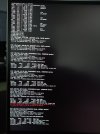After a power outage yesterday, my system was stuck at the grub rescue> prompt.
Following the steps here https://pve.proxmox.com/wiki/Recover_From_Grub_Failure
I created a flash drive with the Proxmox Installer ISO and changed my BIOS to boot from the USB.
When I run `vgscan` there is no output.
When I run `vgchange -ay` also, no output.
When I try to `mount /dev/pve/root /media/RESCUE/` I get "special device /dev/pve/root does not exist".
Thanks, in advance, for your advice.

Following the steps here https://pve.proxmox.com/wiki/Recover_From_Grub_Failure
I created a flash drive with the Proxmox Installer ISO and changed my BIOS to boot from the USB.
When I run `vgscan` there is no output.
When I run `vgchange -ay` also, no output.
When I try to `mount /dev/pve/root /media/RESCUE/` I get "special device /dev/pve/root does not exist".
Thanks, in advance, for your advice.

Last edited:

